#The Fur Trade
Explore tagged Tumblr posts
Text

7 notes
·
View notes
Text
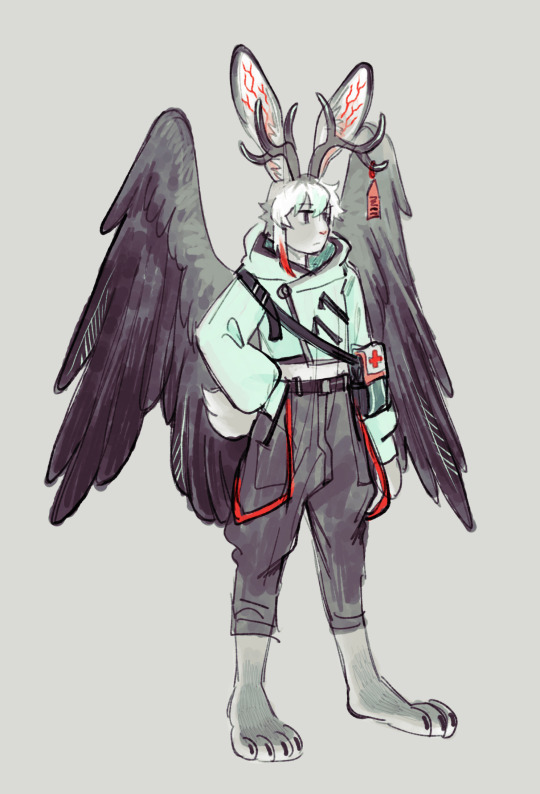
design
#art#furry#furry art#character design#anthro#anthro art#sfw furry art#safe fur work#this was a design for my partner as a part of a trade
759 notes
·
View notes
Photo

my half of an art trade with @ mirnightghost
#this was awesome i gotta do more trades#if anyone is interested in a trade dont be scared to ask though it may have a long wait time#art trade#my art#furry art#sfw furry#fursona#furry fandom#sfw furry art#fur#sfw furry fandom#sfw fur#furry artist#sfw furry artist#feline furry
553 notes
·
View notes
Text
Dry Beast Monday: chinchillas
For over a year now I've been doing weekly Wet Beast Wednesday posts where I do a deep dive on some aquatic animal, and you know what? I'm tired of it! This is now a dry beast blog!* And where better to start than an animal that can literally die if it gets wet? Beasts can't get much dryer than that. So strap in for the first Dry Beast Monday... Dmonday?... Drunday? Whatever, it's the chinchilla.
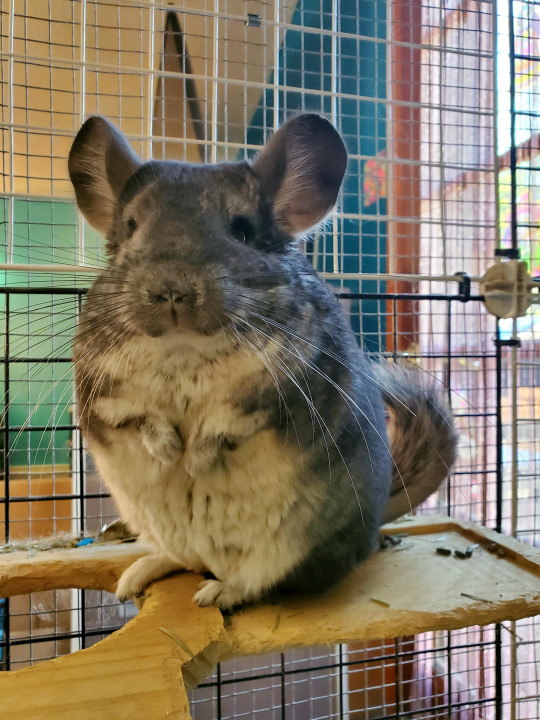
(Image: a pet chinchilla in a cage, standing upright on a wood platform that has been heavily chewed. It is a rotund mammal with a similar body plan to rabbits, featuring a large head distinct from a round body. Its hind paws are larger than the forepaws and have more distinct toes. Its eyes are almost completely black and it has a flat nose with very long whiskers. The ears are large, rounded, and mostly furless. The tail is bristly hair like a squirrel's and is curled up. Most of its fur is a dark grey but the fur on its underside is white. End ID)
Chinchillas are rodents (the best mammals, fight me) that are members of the family Chinchilladae along with the viscachas. There are two living species of chinchilla: the long-tailed chinchilla (Chinchilla lanigera) and the short-tailed chinchilla (Chinchilla chinchilla, formerly Chinchilla brevicaudata). The two species can produce sterile hybrid offspring. Domesticated chinchillas are descended from the long-tailed chinchilla. All chinchillas are medium-sized rodents with powerful back legs, long whiskers, large ears, and extremely dense fur. In comparison, the short-tailed chinchilla is larger and has a shorter tail, thicker and less distinct neck and shoulders, and smaller ears. The most famous feature of chinchillas is their fur. At about 20,000 hairs per square centimeter, chinchillas have the second densest fur of any mammal, second only to sea otters. Each hair follicle grows up to 50 hairs, compared to human follicles, which only grow 1. The fur is famous for being incredibly soft, often described as velvety. If you've never felt a chinchilla its really hard to describe just how soft they are. The fur is so dense because Chinchillas live in the highlands of the Andes mountains where it gets very cold. The fur is used for insulation and even with it being so thick, chinchillas still need to bask in the sun to warm themselves up. The fur is actually the reason why chinchillas can't get wet. Their fur is so dense that wanter can't evaporate easily, instead remaining around long enough for fungus to start growing in the fur. This can lead to a lot of different skin conditions and infections that can be lethal. When chinchillas bathe, they take dust baths. By rolling around in volcanic ash, the can work the ash into their fur, where it absorbs oils, moisture, and other contaminants. This keeps the fur clean and healthy. Domestic chinchillas need specially made dust for their baths. It cannot be substituted with sand or other materials. Chinchillas can release chunks of their fur in order to escape from predators, leaving the predator holding nothing but a tuft of hair while the chinchilla runs away. This is called fur drop and in domestic chinchillas it can be a sign of mishandling or stress. Wild chinchillas have grey fur, but domestic breeds have been bread to have other colors of fur, including white and black. Chinchillas can't sweat, which isn't a problem in their natural habitat, but is for domestic chinchillas. The only way for them to cool down is to expose their ears (which are hairless and heavily vascularized) to wind. Chinchillas in temperatures at or above 26 degrees C (80 F) are at risk of having heat strokes. Daytime in the Andes can exceed those temperatures, so chinchillas hide in burrows during the day. Chinchillas are very skilled at jumping, able to leap up to 1.8 meters (6 ft). Their hind legs are longer than the forelegs and provide propulsion when walking or jumping. The toes has fleshy pads called papillae that help them grip onto surfaces. Chinchillas live in arid, rocky conditions and are skilled at leaping between rocks. The tails act like rudders, providing stability and direction when leaping. The front feet are capable of gripping and picking up objects. Females tend to be larger than the males, but there is otherwise little visual difference between the sexes. Wild short-tailed chinchillas can reach 38 cm (including tail) and 800 grams while wild long-tailed chinchillas can reach 26 cm (including tail) and 450 grams. Domestic chinchillas can get up to twice the size of their wild relatives.

(Image: a wild long-tailed chinchilla sitting under a rock. Its body plan is the same as the pet chinchilla above, but its fur is a lighter grey End ID)

(Image: a short-tailed chinchilla in captivity. It has a less distinct neck than the long-tailed chinchilla, making it look like its head merges with the body. Its tail is shorter than that of the long-tailed chinchilla, making up about 1/5th of its length as compared to the long-tailed chinchilla's 1/3rd. End ID)
Chinchillas are social animals that live in colonies called herds that can reach up to 100 members. Females dominate the herds and can be aggressive toward each other, though physical fights are rare. The herd cooperates when finding food, always having at least one member acting as a lookout to spot predators while the rest feed. They communicate vocally, with 10 types of vocalizations on record for. Social behaviors include grooming, playing, and friendly nibbling of each other's ears. Pet chinchillas should never be kept alone. They should be in same-sex groups of at least 2. Chinchillas are crepuscular, active mostly at dawn and dusk. During the day and night, they are usually found hiding in burrows or crevices between rocks, where they can avoid predators and high or low temperatures. They are primarily herbivores, but will supplement their diets with insects and other bugs. Most of their diet consists of grasses, seeds, and succulents and cacti. Wild ones almost never drink water, instead getting all of their hydration from their food. Chinchilla digestive systems are fairly specialized to their food. Domestic chinchillas need special-formulated food and can only have wooden chew toys form certain species of wood. Fresh or dried fruit is good for a treat, but should not be a regular part of their diet as they have a lot of sugar. As with all rodents, the incisors grow continuously through the animal's entire life and need to be worn down by chewing on things.
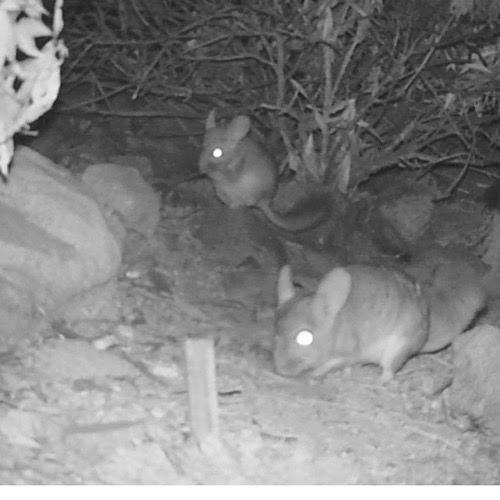
It is surprisingly hard to find good-quality images of wild chinchillas. Most of the time when you search for wild chinchilla pictures what you get are either domestic chinchillas or viscachas.
(Image: a trail-cam shot of two wild long-tailed chinchillas. The photo is i black-and-white. One is in the foreground on all fours while another is on its hind feet in the background, standing on a rock. The terrain is rocky and the chinchillas are next to a shrub. The camera's light makes their eyes appear to glow white. End ID)
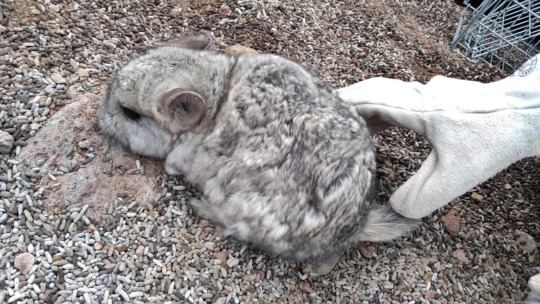
(Image: a wild short-tailed chinchilla that is part of a relocation effort. Its fur is light grey with darker patches. A gloved human hand is reaching in from the right side of the image. End ID)
Male chinchillas appear to be fertile year-round, but females only enter estrus during the winter, from May to November in their natural habitat. Gestation takes around 120 days in both species and both species typically have two litters a year (a low rate for a small mammal). Offspring (called kits) are born well-developed, with fur and open eyes, and can run as soon as they are born. They nurse for 6-8 weeks before being weaned. 1-6 kits are born at a time, with 2 being the usual number. Chinchillas are monogamous, mating for life. Either partner can initiate mating, which they do so with hair-pulling. Unusually for rodents, male chinchillas do provide care for their offspring. Members of the same herd will help each other with parenting. Female chinchillas have been known to adopt the kits of other females who can't nurse due to health issues. Females are usually dominant due to their size. Chinchillas become sexually mature at around 8 months. In the wild they can live for 10 years, which is doubled in captivity.
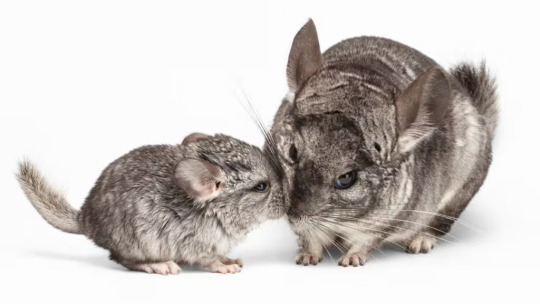
(Image: an adult domestic chinchilla with a juvenile. The juvenile is smaller than the adult, with proportionally larger head and limbs and proportionally smaller tail. The two of them are nuzzling their snouts together. End ID)
The name chinchilla comes from the Chincha people of the Andes, who hunted chinchillas for their fur and meat. This hunting increased vastly after European colonization of South America. Between hunting and trapping, both species of chinchilla were brought to near extinction and vastly reduced their native range. Both species are now only found in Chile and have been granted legal protection. The IUCN switched their classifications between Vulnerable, Endangered, and Critically Endangered for a while. As of 2016, both species are classified as Endangered, upgraded from Critically Endangered as their populations have seen some improvement. Poaching, both for fur and capture for sale as pets, is still a large threat to wild chinchillas. Their close cousins, the viscachas, are doing much better as they were not hit as hard by the fur trade. The domestication of the long-tailed chinchilla is thanks to Mathias F. Chapman, an engineer who became fascinated with the animals after meeting a native person who was trying to sell one. He ended up getting permission from the government of Chile to capture several and import them to the USA. It took him 3 years to catch enough that he considered suitable for breeding, 11 in total. He then spend over a year gradually bringing them down from the highlands to sea level, giving them plenty of time to acclimate to the lower altitude. Once in the USA, Chapman started breeding his chinchillas in a farm in California, though he had to deal with medical problems and a thief stealing half of his stock. Eventually, though, his experiment paid off. The vast majority of all domesticated chinchillas today are descended from those original 11, brought to the states in 1923. Chinchillas today are raised in captivity for their fur, for use as laboratory animals, and as pets. While both species are raised in captivity for fur, the domesticated chinchilla is descended from the long-tailed chinchilla and short-tailed chinchillas apparently do not make as good pets.
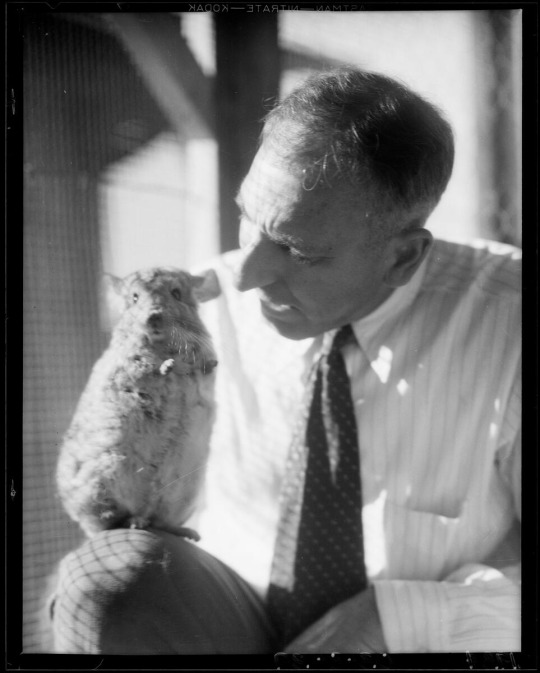
(Image: a black-and-white photo of Mathias F. Chapman, a white man with a large nose wearing a shirt and tie. A chinchilla is standing on his leg and looking at the camera while he looks at the chinchilla. End ID)
* April Fools
#april fool's day#the animal facts are real#dry beasts#dry beast monday#wet beast wednesday#chinchilla#long tailed chinchilla#short tailed chinchilla#domesticated chinchilla#rodent#mammal#biology#ecology#zoology#animal facts#informative#fur trade
119 notes
·
View notes
Text

⭐I FINALLY HAVE NEW ART (besides my ref) art trade w/ new friend Alubune (goes by that on any site) of alters Alu and Warren! wanted to shake off rust and try going back to the old sketchy style do y'all prefer this or the cleaner look with thick lines? ;w; *ragdolls*
118 notes
·
View notes
Text

Art trade with Skiidokia from Twittter :3
#digital art#art#artists on tumblr#artwork#furry#sfw furry#furry art#art study#furry oc#art process#art trade#trade#furry dog#fursona#fur coat#my art
23 notes
·
View notes
Text

no idea what this guy's name is, but he was fun to draw
#not my oc#digital art#art#artists on tumblr#artwork#digital drawing#digital illustration#digitalart#drawings#drawing#feral art#not my character#art for others#feral furry#furry#sfw furry#furry art#furry oc#furry fandom#furries#art work#illustration art#art payment#art trade#at#owed art#owed#orange fur#bells#weirdfur
33 notes
·
View notes
Text

my part of an art trade with @polito0!
#bflyart#polito0#polo#nemo#these were fun characters to draw#i love inking fur#i also love doing art trades with mutuals wink wink
1K notes
·
View notes
Text

Jae Seong for @rachelsquill !! :3
taglist: @snaxle @neonkoii @areus-in-a-little-cave @cupcraft @cnnamonrolls @yourfriendphoenix @wiiwarechronicles @tee-gee-em @tweewig @omegamoo @t3rm1n0s @atthebell @avid-dust-collector @marszstar @frauggiethecreature @exorjack @possuminnit @spider-shoes @coffeeflavored-tears @crimeboys @meeowerzz @routeriver @qjaiden @faglovesongs @bunnyrabbitofficial @jeanbean16 @cloverstellar @tricktack @lifeintheworldtocome @thehelpenchantingfig @lexicled @cathartidae @sneefsnorf @sirpiglin @thinkingabout-girls @birdintheairport (ask to be added/removed)
#fur a silly traditional art trade.... wehehee#mossisgay#art#traditional art#marker art#oc art#original character
41 notes
·
View notes
Text






buncha lil character designs i did recently for peeps on toyhouse :]
355 notes
·
View notes
Text

#art#artists on tumblr#artwork#digital art#my art#original art#oc art#furry anthro#furry adopt#furry commissions#furry community#furry character#fur coat#furry art#sfw furry#fursona#furry#furry oc#furry fandom#furries#commissions welcome#commisions open#commissions open#art commisions#commission#my artwork#art style#art trade#art comms open#art commissions open
21 notes
·
View notes
Text
So I have had a ridiculous amount of fun this last week plushifying art and throwing my usual crafting rules out the window as I did so*, and I think I want to make plushifying art a more regular thing? I'm not sure how best to do that, though. Should I make a post that's like "reblog this if you want your art turned into plushies", or "reblog this with links to art you want turned into plushies" or suggest a tag that people can add to art they want plushified, and then I go through the tag when I want to make some plushies? *no paper patterns, just drawing directly on the fabric so each plushie is one of a kind
#the person behind the yarn#I can't guarantee I'll make all of them#some things are harder to plushify than others#whether for skill level concerns or 3D object concerns or just don't have that fabric concerns#(for the life of me I haven't been able to find purple faux fur)#also when I plushify art the artist always gets first dibs on the plushie#and I am almost always more than happy to send the artist the plushies#either in exchange for an art trade#or if no trade I usually just ask if they are willing to cover the cost of shipping?#if it's got some bought-for-that-project supplies I miiiight ask if they're willing to cover that specific cost#but that would be like. if I had to buy beads and used them all up making the thing#and maybe for more labor intensive plushies??? idk how detailed some of these might be#most of the time it's either art trades or the cost of shipping
39 notes
·
View notes
Text


first drawing of august ^_^
#art trade#my art#artists on tumblr#rainbowcore#digital art#rainbow#eyestrain#scenecore#scene kid#bright colors#accessories#hair clips#detailed#spiked collar#neon colors#neon aesthetic#rainbow colors#puppy#sfw interaction only#fypシ#fyp#sfw furry#safe fur work
22 notes
·
View notes
Text

Silly little thing made with an wellbeing reminder image, it encourages my patrons by giving a head pat when they vote. A traditional which continues to this day!
#furry#timot-ei#furry art#furry oc#anthro#fursona#poodle#sfw furry#fur#my art#furry character#pink#soft pink#pink aesthetic#pinkcore#trade offer#meme#cute art#curvy and cute#head pats#old art#artwork#art#artists on tumblr#digital art#art tag
40 notes
·
View notes
Text

Whisper
#anthro#furry#furry art#my art#artists on tumblr#digital art#sfw furry#anthopomorphic#art trade#character art#sfw fur art
26 notes
·
View notes
Text

Art trade again
Protogen belongs to Vesperupus
24 notes
·
View notes